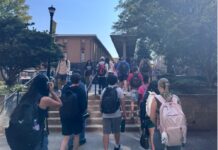
The coronavirus pandemic and its subsequent lockdown dramatically effected the mental health of adolescents. Parents across the country, like Taunya Foster, aren’t oblivious to these changes in their children’s behavior.
“Both of them have a lot more general anxiety going out in places,” Foster said. “They hear somebody cough, they really struggle with not wanting to wear their mask but feeling like they would need to or they would die!”
Front Psychiatry, a medical journal for psychologists, did a meta-analysis of 10 different studies and found that anxiety and depression rates amongst adolescents significantly increased during the coronavirus pandemic.
“The problem with the COVID years, was that [kids] were socially and emotionally isolated from their peers,” said Dr. Charles Jenkins, a clinical child psychologist in Sandy Srpings. “And the lack of social interaction and the fact they are learning alone in their rooms — was extremely damaging.”
How schools are run and organized could be a contributing factor to these increased anxieties.
One of Foster’s major complaints was that she felt the school lacked leniency with the students’ and parents’ schedules. Foster was working full time as a single mother as her children were in school and didn’t have the time to attend to their needs while she was also trying to work and feed them.
“It’s one thing to say that a kid turned in his homework late—I didn’t feel like there was not enough consideration for the fact that you are asking a family, perhaps a single parent family, to stop their life to now support the child’s education in a way the teacher should have been doing,” Foster said.
Chronic absenteeism, which is typically defined as missing one-tenth of the school year, has had a dramatic increase. Forty percent of schools reported a spike in chronic absenteeism during 2021-2022 according to the National Center for Education Statistics. With stories like Foster’s and her family, it’s no surprise why this is the case.
It is not that these students are trying to skip class out of boredom. The definition includes mental and physical health related absences for chronically absent students.
“I have put more kids in hospitals and recovery centers than my previous 30 years combined,” said Jenkins, the child psychologist. “I would easily say I’ve put in 40-50 over the past few years into treatment programs.”
Compared to previous years, Jenkins only had to have two to three children committed per year.
Some schools tried adapting their schedule. Foster mentioned that her children’s schools in Cobb have both opted to have “asynchronous” schedules occasionally, where students stay home and do schoolwork assigned to them online.
Some parents tried to help by giving their children other options. Rachel Johnson is a divorced mother of two and formerly an experienced clinical social worker. Johnson’s daughter Addy is in eleventh grade and switched to online learning after years of public school.
“Schools have lost the practicality and applicability of their classes,” Johnson said. “It’s hard to sell as a parent. I don’t know when you’re gonna use physics. I never even took physics!”
With online schooling, Addy is more selective about what kind of classes she takes, and she can also work at her job at a local nail salon. While Addy still goes to therapy, she likes the change.
“I was tired of the school environment — fellow classmates and the teachers just kind of got worse,” Addy said.
Johnson’s son Caden has severe dyslexia and an ocular motor dysfunction and didn’t succeed with online learning.
“Especially with kids that have any sort of struggles with learning… it’s unrealistic to think that they are going to get any knowledge from someone teaching them through a computer.”
Caden returned to in-person schooling. Johnson’s observations are not unfounded. Nature Human Behavior published a systematic review of several learning studies that suggests on average “students lost about 35% of a normal school year’s learning,” during the pandemic.
However, most parents and children don’t have access to pick and choose the type of schooling they desire, which is why Dr. Jenkins argues that funding needs to be directed toward on-site school mental health counselors and social workers.
Dr. Emiliya Adelson, with the Center for Psychological Discovery, believes there should also be a renewed focus on the mental health care of teachers and those who work in the school.
“The number one protective factor for teens and for kids is positive relationships,” Dr. Adelson said. “Whether that’s a custodian, a math teacher, a school counselor — that can make a world of difference for your teen. But we have to have those adults feeling like they can show up for work too.”
















